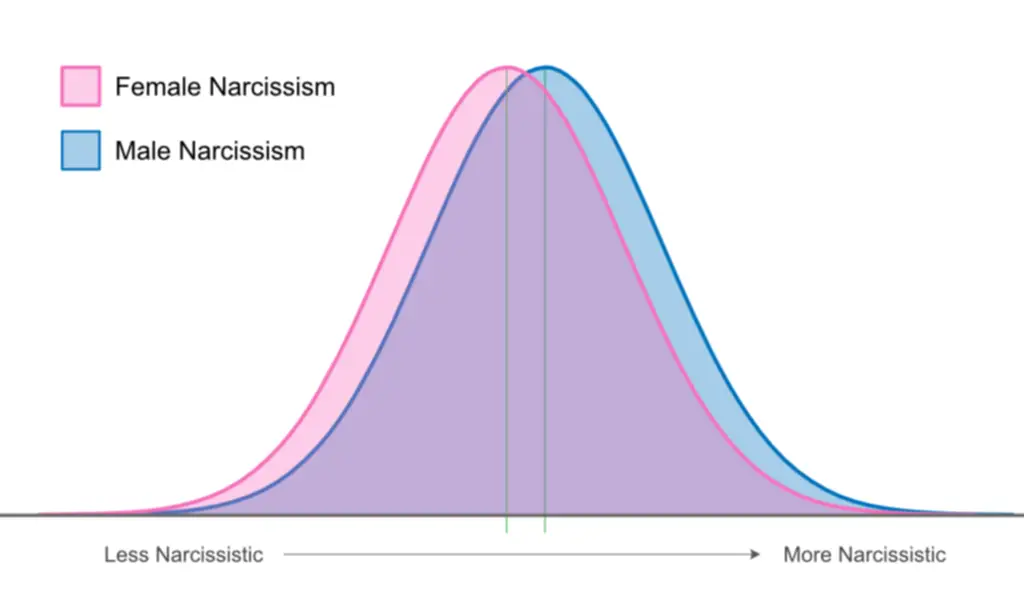Men I know and work with often ask me, “can a woman even be a narcissist?” Popular psychology has pushed the notion that narcissistic personality disorder (NPD) is primarily a male condition, but that what most people believe about narcissism is false. So, can women be narcissists?
Yes, women can be narcissists. Women are only slightly less narcissistic than men on average, with the average offset by just 26% of a standard deviation. One in three people with clinical levels NPD, in the top 1% of severity, are women. Some psychologists believe even more women are narcissists than current tests show.
While this may not come as news to those of us who are male victims of female narcissists, the fact can be a hard sell to our friends and family who are caught up in the popular misconception. For those people, I’ve put together the actual science in the article below to help you understand and convince those around you with hard facts and figures.
Statstics in Grandiose Narcissism in Men and Women
The most extensive review of narcissism data that compares between men and women is “Gender Differences in Narcissism: A Meta-Analytic Review” published in the Psychological Bulletin. In this article, researchers aggregated data from 470,846 questionnaires over 355 different narcissism studies from 1990 to 2013.
- The difference between male levels of narcissism and female levels of narcissism is measurable, and about 26% of a standard distribution
- These differences remain the same despite the age of the narcissist
- These differences have remained the same over time
While the conclusions the paper makes are mathematically certain, but what do all these numbers mean?
Below I show how relatively narcissistic men and women are, with the least narcissistic on the left and the most narcissistic on the right. I hope this makes it easy to see that many women are noticeably above average in terms of narcissistic traits. And certainly, female narcissists do exist.

To summarize, on the scale of narcissism, men score slightly higher than women on average, but extremely dangerous female narcissists exist.
How Many Women are Narcissists
In terms of clinical levels of narcissism, as defined by the DSM-V, the percentage of the general population is assumed to be less than 1%. Because the tests used in this study, such as the Narcissistic Personality Inventory (NPI) cannot diagnose narcissism, it is not clear exactly how much clinical NPD is affected by sex.
As a quick estimate, assuming equal standard deviations with a 0.26 sigma offset, of the 1% most highly narcissistic individuals, about one third are women and two-thirds are men. Another way of saying this is that 0.7% of women (2.3 million in the United States and 55 million worldwide) are likely suffer from clinical NPD*
Interested in if you might be in a relationship with a narcissist? See my article “Signs of a Narcissist | 21 Behaviors of the Classical Narcissist” for help with determining if you have a narcissist in your life.
Men and Women are Equally Likely to be Vulnerable Narcissists
Another astonishing fact unearthed by this publication is that men and women are equally likely to be vulnerable narcissists. Vulnerable narcissists are a less studied group of narcissists than the grandiose or classical narcissism discussed above. But, they can be more dangerous because they are harder to recognize.
Do you have a vulnerable narcissist in your life? Click to find out —
12 Signs of A Vulnerable Narcissist | Spot Them Before They Harm You
Why More Women May Be Narcissists than We Currently Recognize
According to Gender and Narcissism by Ilene Philipson, there is serious reason to believe that women are being underdiagnosed with narcissism. The case studies and published work that established narcissism as a psychological condition predominantly focused on male patients, with women being represented less than half the time.
This skewing of the data may have lead psychologists to define narcissism in a way the applies more directly to the male experience. While women who suffer from similar psychological conditions may be more likely to be classified with similar disorders, such as bipolar, or not diagnosed at all.
Tt might be that gender differences in the distribution of narcissistic traits are, in fact, due to bias in testing. And that with a more refined set of questions beyond or in addition to the most commonly employed Narcissistic Personality Inventory (NPI), women might be precisely as narcissistic as men.

